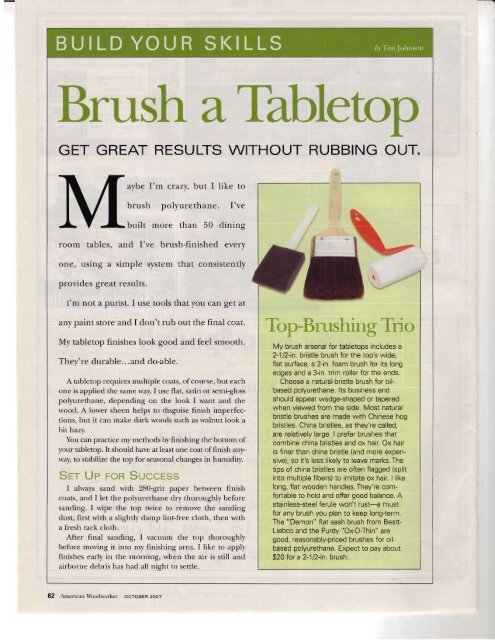AW #131.pdf - Karatunov.net
AW #131.pdf - Karatunov.net
AW #131.pdf - Karatunov.net
You also want an ePaper? Increase the reach of your titles
YUMPU automatically turns print PDFs into web optimized ePapers that Google loves.
Brush affietry<br />
GET GREAT RESULTS WITHOUT RUBBING OUT.<br />
aybe I'm crazy, but I like to<br />
brush polyurethane. I've<br />
built more than 50 dining<br />
room tables, and I've brush-finished every<br />
one, using a simple system that consistently<br />
provides great results.<br />
I'm not a purist. I use tools that you can get at<br />
any paint store and I don't rub out the final coat.<br />
My tabletop finishes look good and feel smooth.<br />
They're durable...and do-able.<br />
A tabletop requires multiple coats, of course, but each<br />
one is applied the same way. I use flat, satin or semi-gloss<br />
polyurethane, depending on the look I want and the<br />
wood. A lower sheen helps to disguise finish imperfections,<br />
but it can make dark woods such as walnut look a<br />
bit hazy.<br />
You can practice my methods by finishing the bottom of<br />
your tabletop. It should have at least one coat offinish any-<br />
\{?y, to stabilize the top for seasonal changes in humidity.<br />
Srr UP FoR Succrss<br />
I always sand with 280-grit paper between frnish<br />
coats, and I let the polyr.rrethane dry thoroughly before<br />
sanding. I wipe the top twice to remove the sanding<br />
dust, first with a slightly damp lint-free cloth, then with<br />
a fresh tack cloth.<br />
After final sanding, I vacuum the top thoroughly<br />
before moving it into my finishing area. I like to apply<br />
finishes early in the morning, when the air is still and<br />
airborne debris has had all night to settle.<br />
82 American Woodworker OCToBER 2oo7<br />
Ttp-Brushing Trio<br />
My brush arsenal for tabletops includes a<br />
2-112-in. bristle brush for the top's wide,<br />
flat surface, a 2-in. foam brush for its long<br />
edges and a 3-in. trim roller for the ends.<br />
Choose a natural-bristle brush for oilbased<br />
polvurethane. lts business end<br />
should appear wedge-shaped or tapered<br />
when viewed from the side. Most natural<br />
bristle brushes are made with Chinese hog<br />
bristles. China bristles, as they're called,<br />
are relatively large. I prefer brushes that<br />
combine china bristles and ox hair. Ox hair<br />
is finer than china bristle (and more exoensive),<br />
so it's less likely to leave marks. The<br />
tips of china bristles are often flagged (split<br />
into multiple fibers) to imitate ox hair. I like<br />
long, flat wooden handles. They're comfortable<br />
to hold and offer good balance. A<br />
stainless-steel ferule won't rust-a must<br />
for any brush you plan to keep long-term.<br />
The "Demon" flat sash brush from Bestt-<br />
Liebco and the Purdy "Ox-O-Thin" are<br />
good, reasonably-priced brushes for oilbased<br />
polyurethane. Expect to pay about<br />
$20 for a 2-112-in. brush.










